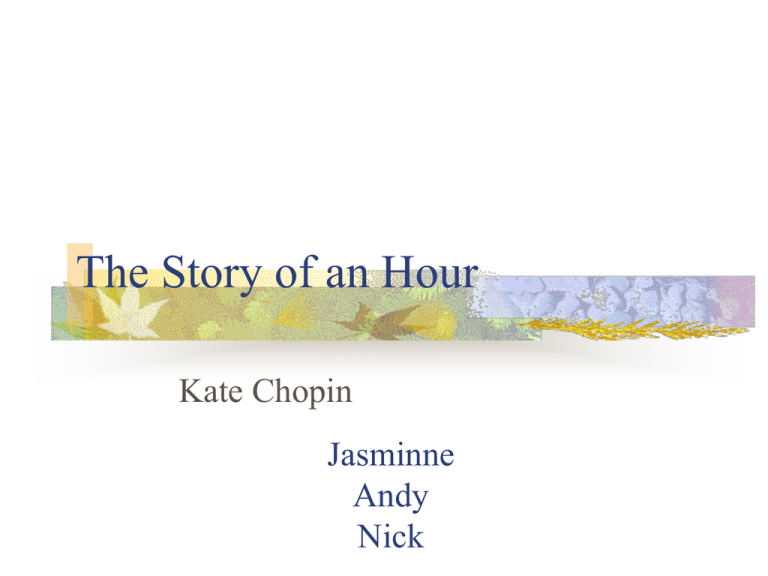The Story of an Hour
advertisement

The Story of an Hour Kate Chopin Jasminne Andy Nick Thesis Live your life for yourself and not anyone else, because your chance at freedom may come to late in your life. “But she saw beyond that bitter moment a long procession of years to come that would belong to her absolutely. And she opened and spread her arms out to them in welcome.” Tone Begins with a calm logical tone. “Knowing that Mrs. Mallard was afflicted with a heart trouble, great care was taken to break to her as gently as possible the news of her husband's death.” Switches to more emotional and elated tone of a new found freedom. “They stayed keen and bright. Her pulses beat fast, and the coursing blood warmed and relaxed every inch of her body.” Purpose Women had boundaries set by men, and were thought to only live for their husbands or men in their life. Chopin wrote this to show how men weren’t the only means of happiness in a women’s life. Audience This story is mainly written for women. For women it was a way to show them that freedom may come to late in their lives so they should live their lives for themselves. Evidence When she sits by her window after crying she begins to notice the flowers blooming and many other things around her.Things only noticed when someone is happy. “There was something coming to her and she was waiting for it, fearfully. What was it? She did not know; it was too subtle and elusive to name. But she felt it, creeping out of the sky, reaching toward her through the sounds, the scents, the color that filled the air.” Appeals Pathos: Emotions revealed vary from sad, confused, joyful, and ends with a bittersweet death. “She did not stop to ask if it were or were not a monstrous joy that held her.” “Into this she sank, pressed down by a physical exhaustion that haunted her body and seemed to reach into her soul .” Assumptions Women’s lives were restrained to certain thoughts and emotions, not all could be evoked. “There would be no one to live for during those coming years; she would live for herself. There would be no powerful will bending hers in that blind persistence with which men and women believe they have a right to impose a private will upon a fellow-creature.” Style:Rhetorical Mode Descriptive:The essay develops through the accumulation of concrete and specific details revealing the repression of women by men as it is experienced by Mrs. Mallard. “She was young, with a fair, calm face, whose lines bespoke repression and even a certain strength. But now there was a dull stare in her eyes, whose gaze was fixed away off yonder on one of those patches of blue sky. It was not a glance of reflection, but rather indicated a suspension of intelligent thought.” Style:Syntax The story begins with a regular, logical and to the point sentence. As the story unravels we begin to get shorter sentences. “The delicious breath of rain was in the air. In the street below a peddler was crying his wares.” Style: Syntax (cont.) We also receive more pauses. (commas,semicolons,periods) “There was something coming to her and she was waiting for it, fearfully. What was it? She did not know; it was too subtle and elusive to name. But she felt it, creeping out of the sky, reaching toward her through the sounds, the scents, the color that filled the air.” This creates a more rapid tone then the beginning sentence. Ends with a simple sentence, “When the doctors came they said she had died of heart disease--of the joy that kills. ” Style:others Simile: “…except when a sob came up into her throat and shook her, as a child who has cried itself to sleep continues to sob in its dreams.” Imagery: “She could see in the open square before her house the tops of trees that were all aquiver with the new spring life... and countless sparrows were twittering in the eaves. There were patches of blue sky showing here and there through the clouds that had met and piled one above the other in the west facing her window.” Irony: “When the doctors came they said she had died of heart disease--of the joy that kills.” Works Cited The Story of an Hour. (2007, March 15). In Wikipedia, The Free Encyclopedia. Retrieved 03:56, March 16, 2007, from http://en.wikipedia.org/w/index.php?title=The_Story_of_an_Hour&ol did=115258536 Stifler, Ben. "Rhetorical Modes." 2002. 15 Mar 2007 http://users.cdc.net/~stifler/en110/modes.html Braiman, Jay. "LITERARY DEVICES." 2003. 15 Mar 2007 http://mrbraiman.home.att.net/lit.htm The End.



